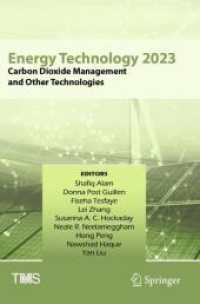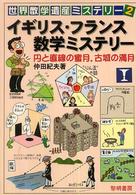- ホーム
- > 洋書
- > 英文書
- > Science / Mathematics
Full Description
Product Safety and Restricted Substances in Apparel emphasis on the overview of the restricted substances present in fabrics, apparels and accessories and their acceptable limits or total ban, management of such restricted substances in the supply chain, standard and regulatory test methods. Manufacturing Restricted Substances address hazardous substances potentially used and discharged into the environment during manufacturing and related processes, not just those substances that could be present in finished products. Safety requirements and review of risk of different garments have been covered including varieties of accessories. Global and country specific regulations on the restriction of various harmful chemicals used in the manufacturing process of fabrics, apparels and related accessories are also discussed in detail.
The book is aimed at textile and apparel industry professionals, retailers, factory heads, buying offices and students intending to join the industry in the areas of quality assurance covering safety and chemical compliance.
Contents
Introduction
Risk analysis of textile and apparel
Sources of restricted substances in textile and apparel
Evaluation of restricted substances
Legal requirements of harmful substances
Product compliance for environmental protection
Need for chemical management system
References
Management of restricted substances in the textile and apparel supply chain
Purpose and importance of restricted substances list
Risk associated with restricted substances
Education of the supply chain
Importance of evaluation through testing
Implementation procedure of a RSL program
References
Review of restricted substances in textile and apparel supply chain
Introduction
Restricted substances in fabric
Restricted substances in trim
Restricted substances in embellishments
Restricted substances in apparel
Overview of Manufacturing Restricted Substances List (MRSL) (41, 42)
References
Compliance of restricted substances in safety aspects of textile and apparel
Introduction
Banned amines in azo dyes
Allergenic disperse dyes
Carcinogenic dyes
Formaldehyde
Heavy metals
Pentachlorophenol, tetrachlorophenol, and orthophenylphenol
Organotin compounds
Chlorinated organic carriers
Fluorocarbons
Phthalates
Polyvinyl chloride
Alkyl phenol ethoxylates
Flame retardants
Polyaromatic hydrocarbons (PAH)
Solvents
Dioxins and furans
Residual pesticides
Chlorinated paraffins
Dimethyl fumarate (DMFu)
Isocyanates
Asbestos
Adsorbable organic halides (AOX)
References
Product safety requirements of children's apparel
Importance of safety issues
Small parts - choking hazards
Metal fasteners
Zipper fasteners
Dungaree clips (hasps) and sliders
D-rings
Functional and non-functional drawstrings, cord/ties
Toggles
Fixed bows
Buttons
Pom-poms and frings
Decorative trims and embellishments
Bead
Sequins
Jewel
Heat transfer diamante (rhinstone) and stud guidelines
Fire safety
Sun protection
References
Safety review of children's apparel
Introduction
Safety review
Flammability requirements in children apparel
References
Some important test methods to evaluate restricted substances in textile and apparel
Introduction
Lead content in surface coating
Lead content in substrate (metal)
Lead content in substrate (non-metal)
Cadmium in coated/plastic items
Evaluation of phthalates
Nickel release test: BS EN 1811 (22) and BS EN 12472 (23)
Test method for formaldehyde (24)
Test method of azo dyes (25, 26)
Test method of azo dyes (polyester fabric) (27, 28)
New standard for azo dyes
Miscellaneous test methods
References
Global regulatory requirements on harmful substances in textile and apparel
Introduction
Canada Hazardous Products Act
Canada Consumer Product Safety Act (CCPSA)
EU regulations
Global Organic Textile Standard (GOTS)
OEKO- TEX Standard 100
US regulations
China (GB18401-2010)
Korea Certification
Japanese regulation (28, 29)
Regulation of Vietnam (32, 33)
Regulation of Taiwan (34)
Regulation of India (35, 36, 37)
References
Understanding chemical management system for compliance in textile/apparel supply chain
Introduction
Practices for restricted substances compliance (1)
Role of NGO campaigns to tackle toxic chemicals
Understanding of 11 classes of priority chemicals (2)
Impact of zero discharge of hazardous chemicals on the supply chain (2)
References
Conclusion







